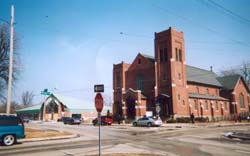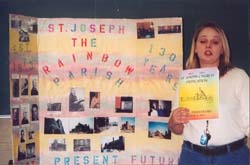
Home
- Artifacts
- Buildings & Businesses
- Churches
- Holidays & Celebrations
- Counties/Locations
- Delta College
- Early Settlers
- Ethnic Background
- Local, Michigan, U.S. and World Events
- Family Genealogy
- Farming
- Libraries & Museums
- Local Sites
- Logging
- Musicians, Artists & Famous People
- Nature, Weather & Four Seasons
- Railroads
- Schools
- Sports
If it is of God, It will be . . .
The Start of Joseph's
 |
St. Joseph's Parish has changed in many ways throughout the years. Located in a once thriving area of northeastern Saginaw, there stood an old wooden structure known as St. Joseph's. Father Vanderboom encouraged the members of St. Mary's Cathedral to build this structure in an area known as the "First Ward". Upon the completion of the structure a father named Richard Sweeny ran the church for some forty-one years. ("St. Joe's 1873-1948")
As the years went on St. Joe's became known for the many services it offered to its parishioners as well as the general public. These services, just to name a few, were health care, schooling, and the hospitality to help anyone, not just the people that came to the parish on a regular basis. St. Joe's became known for its outstanding ability to reach out to the community and nurture those in need. This especially valuable trait that the church acquired throughout the years would eventually become the strength of St. Joe's later in history. The First Ward was a very popular area in the 1800s, due to the Potter Street Train Depot, a major source of transportation for Saginaw, located only a few blocks away from the parish.
Moreover, the impact St. Joseph's Parish began to have on the community began to grow stronger and stronger each and every year. With the frequency of priests changing on an average of about one every nine years, some would stay only one to two years while others would stay for lengthy periods of time. In these years some would make some significant changes, while others would seem to let the church run by itself. In the forty-one year reign of service to St. Joseph's, Father Sweeny had a profound effect on the parish. Sweeny would develop a new school that would operate well into the 1900s. He also brought about the construction of a convent, which was run by a group of Dominican sisters from Grand Rapids. The convent would also be a first for the city of Saginaw ("St. Joe's 1873-1948")
The second Father, named K. J. Whalen, had a short but valuable one-year term at the parish. In his short time at the church he would expand the school to cater to the overwhelming flow of enrollment. To this day I hear the older generation telling stories such as how strict the sisters were as well as reminiscing on the fond memories of their
childhood experiences at St. Joseph's school. Father Whalen was transferred to Muskegon, leaving the parish to his brother, Thomas Whalen. Father Thomas would become an icon of the parish for eight years, until his death in 1924. In his eight years at St. Joe's he transformed the wooden walls that surrounded the structure to brick, as well as rejuvenated the interior.
Several years would pass with no major changes until 1933, when Rev. Fr. Constantine A. Skrowronski came to the parish. At this point the church had begun to feel financially burdened by a mortgage debt. Fr. Skrowronski and several members of the men's club knew this would have to be taken care of, which they succeeded in doing in 1938. All of the $3900.00 owed was paid, according to a local news article ( "St. Joe's last debt"). The liquidation of this debt would pave the way
For a new priest, Monsignor. Harold Bolton, who would for the next eleven years revitalize the churches sanctuary, the convent, as well as the chapel. And by the end of his service, he developed the health care clinic for migrants in need of quality medical services. These changes would all take place in Bolton's first few years at the church. By the end of his mission he had also developed a credit union, which brings us to some of our more recent fathers, such as Fr. LaMarre, Fr. Anholzer, and Fr. Petromouix.
Father LaMarre, a vital force in establishing the human relations department at the diocese as well as the community affairs department, still occasionally frequents the present masses held by the parish. Over the next forty years, five more priests would bring fresh ideas to the church, some which would benefit St. Joseph’s, while others would eventually lead to the almost certain closure of the church. During this time several clubs and organizations were formed, such as the Women's Club, Isodora's Club, Knights of Columbus as well as the Knights of Peter Claver and the Las Damas of Guadalupe, all are still active groups in St. Joseph's Parish today.
A New Era Emerges
 |
In 1984, yet a new era for St. Joseph's began to emerge. This era would come to be known as "The Rainbow Parish of Love". The basis for this name stemmed from its congregation, which consisted of several different cultures and ethnic backgrounds. St. Joe's ability to have such a diverse congregation makes it that much more unique. The parish is not only made up of different colors like the rainbow, but of different age groups: the youthful and the elderly, as well as the rich and the poor, people from the suburbs and people from right here in the neglected part of northeastern Saginaw where the church still stands today in the First Ward.
Father Daniel Anholzer: A Young Vibrant Soul
Within one year, in 1995, the church would have a new leader by the name of Father Daniel Anholzer, a young vibrant soul, who would come to the church with the intent to close the doors for good, letting it succumb to its fate like the rest of the aging Potter Street area. Father Dan, as we all call him, came ready to do the job he was sent to do, but after getting to know the congregation he saw how rich the spirit of the rainbow parish was. Fr. Dan would begin his search for the pot of gold at the end of this rainbow. Realizing that there was more hope in saving the church from closure than actually closing the doors for good, Father Dan would begin an astonishing seventeen- year reign. In previous years, the church had various pieces of its puzzle misplaced, lost, or just not fitting into place. These pieces were the members that left to go to different churches, which would lead to the lost spirit of the parish.
When Father Dan and the parish decided to find the spirit that was lost, they also decided that they needed to eliminate services that were not needed, such as two priests, one for the Spanish Mass and one for the English Mass. In addition, in order for the church to survive, they had to convince members that they needed to contribute to a place they had come to believe wasn't theirs. Father Dan began to inform the parish that priests would always come and go, but it was up to them to support the church-- only then did things begin to change ("St. Joe's Too Much Life"). Although many people were skeptical that keeping the church open would work, they d enveloped the motto that "If it is of God, It will be". As Anholzer started-to-organize members of the dwindling parish, he also began to put the puzzle back together again; the missing pieces that had left the parish began
to come back to St. Joseph's. People began to give more freely to their church in time as well money. It was at this point that St. Joseph's Rainbow Parish began to shine. In an article the church secretary, Ester Fulgencio, was quoted as saying, "Everyone kept telling us how poor we were and we believed it. But he (Anholzer) came along and said we can do anything and gave us some ideas, People went for it" ("Inner City"). The ideas consisted of raffles, fund-raisers, dances, festivals, and bake sales, just to name a few. Eventually the parish generated enough money to repair the old church and rebuild a new parish.
Beginning of Construction
However, as the construction of the new church began in the spring of 2002, like all the forefathers, Father Dan would take on a new mission, becoming the Provincial Leader of the Capuchin Order of Detroit. The parish was devastated; members were unsure that the-efforts they had made would continue without a leader such as him. Father Dan was to St. Joseph's what peanut butter is to jelly. The church was in dismay; many members depended on Father Dan; they relied on his wisdom and guidance. He shared in many families' happy and sad times with religious sacraments. I recall some of my own fond memories in the old parish with my children receiving their sacraments of baptism, confirmation, as well as communion and my marriage-- all performed by Father Dan. While other members share in some of the same events I do, you will find plenty of the older members have attended the parish as children themselves, and are now watching their children, grandchildren, and even great grandchildren start their religious journey. But as Fr. Dan left St. Joseph's to Father Leo Petromouix, he informed us that he was not our strength—that the strength was in the spirit of the church and its members.
In 130 years of a not-so-certain history, St. Joseph's Parish has seen its share of ups and downs. From ministering to the needs of the neighborhood to concentrating on the needs of the church itself, St. Joe's has survived. In April of 2003, we found the pot of gold at the end of the rainbow-- a new church on the same block as the old one. Several of the past, present, and future priests were on hand to officiate the church along with Bishop Ken Untener.
While dedicating the new parish, Bishop Untener described the church as the "Center for the cross of Christ... and may the lifting up of this church be lifting up of this community, including those who are not always welcome, and may this be a sign of peace in a neighborhood that has not always seen peace” ("St.Joe's Dedicated"). In the end, as we celebrate the milestones of the members of the parish and reminisce of all the memories of past churches that stood at Sixth and Sears in the "First Ward," we again start a new era with a new church, a new priest, and yet another motto by Bishop Ken "The Miracle on Sixth Street".
Works Cited
- Anholzer, Father Dan. " Saginaw St. Joseph's Too Much Life to Close." The Catholic Weekly: 2003.
- Blayton, Zada. "Inner City Saginaw Mixed Congregation Won't Let Church Die." The Saginaw News, 1991.
Pastoral Team, St. Joseph's " St. Joseph's Church Dedication 1873-2003." 130 Year Anniversary Saginaw , Michigan 2003 - "St. Joseph's Last Debt Liquidated." The Saginaw News 1938. n.p.
- St. Joseph's Parish. " St. Joseph's Parish 1873-1948" Saginaw , MI. 1949.
- Sirianni, Steve. " St. Joseph's Church Dedicated" The Catholic Weekly 2003.
| The written and visual works in Mid-Michigan Remembers-Stories about Us were chosen on the basis of their quality, diversity, community interest and appeal. Views expressed do not necessarily reflect those of the College. This space is provided as a service by Delta College. |